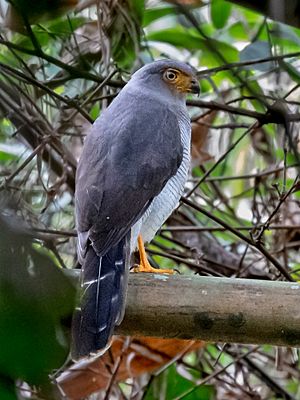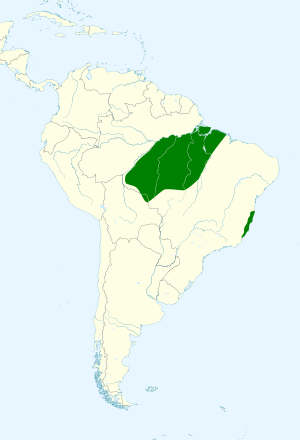Cryptic forest falcon facts for kids
Quick facts for kids Cryptic forest falcon |
|
|---|---|
 |
|
| Conservation status | |
| Scientific classification | |
| Genus: |
Micrastur
|
| Species: |
mintoni
|
 |
|
The cryptic forest falcon (Micrastur mintoni) is a type of bird of prey that belongs to the Falconidae family. You can find it in the southeastern Amazon rainforest in Brazil and Bolivia. Even though it's not seen very often in the Amazon, it lives across a wide area. Because of this, groups like BirdLife International and IUCN say it's a species of least concern, meaning it's not currently in danger.
This bird has often been confused with the lined forest falcon. But adult cryptic forest falcons have a special mark: just one white band on their tail, plus a thin white tip.
Contents
What Does the Cryptic Forest Falcon Look Like?
The cryptic forest falcon is a bird of prey that's hard to spot. When people do see it, they often mix it up with other similar falcons. These include the barred forest falcon, the lined forest falcon, and the plumbeous forest falcon.
While it has some small differences in how it looks, the best way to tell it apart is by its unique calls. This bird is about 30 to 35 centimeters (12-14 inches) tall. Females weigh between 170 and 264 grams, and males weigh between 171 and 238 grams.
Its feathers are mostly grey, often darker on its head. Its upper wings and back are blackish. It has bare red skin on its face. A single wide white bar on its tail helps tell it apart from the barred forest falcon. Young falcons have two thinner white tail bands. Sometimes, there's another tail band hidden by the feathers on its back.
The bird's chin, middle throat, and belly are white. Its chest is white with thin dark grey bars. These bars are usually bolder in females. They are also clearer near the bird's lower throat and upper chest. Young birds have much fewer of these bars. It has a black beak with an orange base and grey eyes. Sometimes, young birds have a diagonal line across their cheek. Its legs are orange with black claws.
Are Male and Female Cryptic Forest Falcons Different?
Male and female cryptic forest falcons look only a little bit different. Females tend to be a bit heavier. They also have bolder dark bars on their chest and belly.
Where Does the Cryptic Forest Falcon Live?
The cryptic forest falcon lives mainly in the Lowland terra firme forests of South America. These forests have tall trees and a thick, varied undergrowth. It also visits the Várzea forest, which is a forest that floods during certain seasons and has bamboo growing in it. There's also a group of these falcons in the Atlantic Rainforest in eastern South America.
How Wide is Their Home Range?
This bird lives across a very large area in South America. It's thought to cover over 19,300,000 square kilometers (about 7.4 million square miles).
There are two main groups of cryptic forest falcons. The first group lives across southeastern Amazonia, from northeastern Bolivia to Pará, Brazil.
Another group, which was thought to be possibly gone, was found again in 2012. This group lives in the Atlantic Rainforest of eastern South America. We don't know much about the current state of this group, but it's likely in critical danger.
How Does the Cryptic Forest Falcon Behave?
What Sounds Do They Make?
The cryptic forest falcon is best known for its calls, especially its unique song. This song is a series of "uk uk uk uk" notes, about one note per second. The song usually lasts for 1 to 1.5 minutes. The bird uses this song to tell other birds about its territory.
Besides its song, the forest falcon has two other calls. One is a cackling call. This is a series of short "ca ca ca ca-ca-ca" notes. The last three notes are closer together and get lower in sound. Its quacking call is heard less often. It's made of loud "uuk, qui, qua-qua" notes.
You usually hear the cryptic forest falcon at dawn (sunrise). But sometimes, you can hear it later in the morning during the dry season. It's less often heard just before dusk (sunset).
What Do They Eat and How Do They Hunt?
What's on Their Menu?
The cryptic forest falcon is thought to eat many different things. It is known to hunt reptiles and insects. It's also believed to eat small birds. For example, one falcon came out when a recording of a rufous-necked puffbird was played.
How Do They Catch Food?
We don't know much about how this falcon hunts. But it's believed to hunt like other forest falcons. It probably watches from low branches in the forest. Then, it quickly flies out to catch its prey.
How Do They Raise Their Young?
Very little is known about how cryptic forest falcons breed. It's thought that they nest during the wet season (December to May). This is supported by signs of a possible nesting hole found on a female bird in early June. Like other forest-falcons, they are thought to nest in tree holes. A new generation of these falcons appears about every 8.6 years.
How Many Cryptic Forest Falcons Are There?
The number of cryptic forest falcons in an area is thought to be similar to the lined forest falcon. This is about one pair for every 20 to 67 hectares (about 50-165 acres). However, during the dry season, as many as 3 to 4 pairs per kilometer have been seen at dawn.
Do They Move Around?
The cryptic forest falcon is believed to stay in one place. It does not migrate (move to different places for seasons).
Are Cryptic Forest Falcons in Danger?
The IUCN Red List said the cryptic forest falcon was of "least concern" in 2016. This means it's not currently facing a high risk of dying out. This is mainly because it lives across a very large area.
However, this large area is getting smaller. A study of forest changes from 2000 to 2012 showed that this bird lost 22% of its home in three generations. This has led some people to think it should be considered "Near Threatened" globally. We don't know the exact number of these birds, but it's believed to be going down. This decrease is mostly due to losing their habitat because of deforestation (when forests are cut down). It's thought that they might lose 34-51% of their home over three generations (about 26 years).
What About the Atlantic Rainforest Group?
The group of cryptic forest falcons in the Atlantic rainforest was thought to be in critical danger or even gone. This was because of habitat loss in that area. Also, no birds were collected after 1933 (these were first thought to be lined forest falcons, but later found to be cryptic forest falcons).
Then, in 2012, this group was found again in Southern Brazil! More research is needed to count this group and find out how much of their home is left. This group is likely in critical danger.
How Was the Cryptic Forest Falcon Discovered?
For a long time, specimens of the cryptic forest falcon were mistakenly called lined forest falcons. It was first recognized as a new species by Andrew Whittaker in 2002. He noticed its very unique calls. Museum specimens also showed that it looked a little different from other falcons in its group.
Whittaker then named the species Micrastur mintoni. He did this to honor Clive D. T. Minton, who was a shore-bird expert and Whittaker's mentor.
See also
 In Spanish: Halcón montés críptico para niños
In Spanish: Halcón montés críptico para niños


